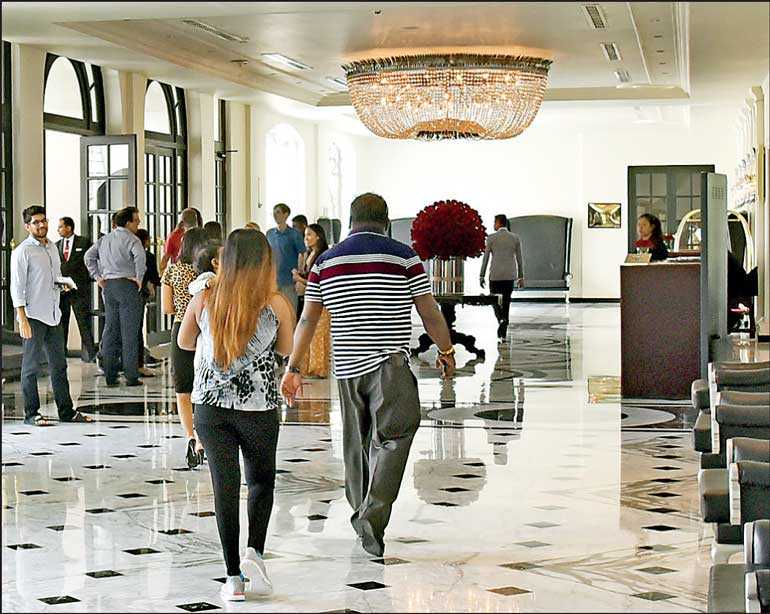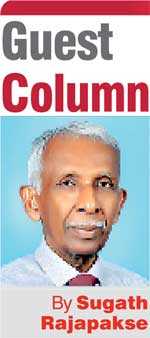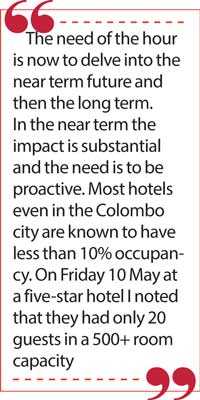Saturday Apr 27, 2024
Saturday Apr 27, 2024
Wednesday, 22 May 2019 00:00 - - {{hitsCtrl.values.hits}}

Easter Sunday 21 April terror acts have dealt a very heavy blow on tourism. The inflow has dried up for the moment while it can be presumed that forward selling too may have become sluggish. It is noted that Government has introduced a series of measures to alleviate the impact, but whether these are adequate to mitigate the impact  on hotels and other service providers, needs to be seen from the next few weeks’ booking activity in hotels and airlines.
on hotels and other service providers, needs to be seen from the next few weeks’ booking activity in hotels and airlines.
The need of the hour is now to delve into the near term future and then the long term. In the near term the impact is substantial and the need is to be proactive. Most hotels even in the Colombo city are known to have less than 10% occupancy. On Friday 10 May at a five-star hotel I noted that they had only 20 guests in a 500+ room capacity.
From a Revenue Management perspective, given very low probability of occupancy of rooms, the Expected Marginal Revenue which is the measure of the probability of a room will be booked on the day multiplied by the current room rate have dropped to very low levels. Each day unoccupied rooms perish in revenue opportunity plus the 40% or so in-house income that is derived from an occupied room is also lost. Therefore, hotels are losing in the room occupancy as well in all laterally integrated profit centres (such as restaurants, room service and others) of the hotels. Thus the compelling need is to first boost occupancy before looking at RevPAR (revenue per available room) and RevPAG (revenue per available guest).
Improving occupancy
On 24 July 2001 terror struck where LTTE terrorists attacked the Colombo airport in which six Sri Lankan Air Force personnel and one soldier died along with 14 LTTE terrorists; 26 aircrafts were damaged or destroyed including four SriLankan Airlines Airbus planes. A further two suffered extensive damage but were repaired after several months. The impact on inbound tourism was felt immediately with many cancellations on the immediate and near future flights, which was felt downstream in hotels and with other service providers.
SriLankan Airlines joined hands with Sri Lanka Association of Inbound Tour Operators (SLAITO) and Hotels Association to introduce the Buy One Get One Free scheme. From an arithmetic perspective, it may be seen as a 50% discount. But given the human psychographics, the giving of one free was an instant success. This scheme was applied to all of the inbound traffic from India.
However, there are a number of differences from 2001 to 2019:
1.Social media – Facebook began in 2004, WhatsApp in 2009 and WeChat in 2011 (social media has a big influence on all aspects our lives). The influence and impact of social media in our daily lives cannot be overemphasised. More often than not, it is the misinformation that gets circulated.
2.Digital marketing has replaced conventional marketing and online selling in the travel industry has increased its share exponentially (in its share of the travel market).
3. The traditional downward integration of airline seat inventory with outbound tour operators of generating countries has diminished in its influence. This is because in early 2001, the traditional outbound operators were reigning high. Thus airlines and hoteliers entered into agreements with them on seats and rooms based on seasonality. Tour operators printed brochures, and did transactions with customers in their outlets.
4.In the present situation hotels and airlines can use the digital marketing with Online Travel Agents (OTA) and other tour operators to push ahead with the sales drive which will impact positively the tourist arrivals and hotel occupancy. The best confidence builder in service industry are the impressions of those who used the services.
According to the latest data from Euromonitor International, “No region better illustrates the emergence of the digital consumer more than Asia Pacific. The region leads the world in the number of internet users, due to the rise of mobile. The expansion of connectivity has also transformed life for Asia Pacific consumers, with these users embracing the ubiquity of the mobile device more than those in any other region”. As of 2018, 51% of the internet users globally reside in Asia Pacific.
Expected Marginal Revenue (EMR)
The hospitality industry today is empowered by Revenue Management (RM). There are a number of such applications where the software and the technical support equipment is provided together with training of RM staff, who will then have to run the RM operation for the hotel. But for this there is need for a certain level of room inventory critical mass as otherwise it is quite difficult to do forecasting and optimisation. For example, having just about 20 rooms in a hotel, it is difficult for the forecaster to forecast what the expected bookings would be based on previous year same time booking data and for optimiser to give an optimisation based on the current variables that can impact occupancy.
In some cases, the providers carry out all the work for the hotels, and only seek an income share when there is incremental revenue accrued to the hotel compared to the same period previous year. However, in the current context the RM providers may not opt unless assured of some revenue as it is difficult to see revenues being optimised above that of 2018, particularly in the near term for 2019. Most branded hotels do have RM, while many other standalone properties do not use RM.
This is something that all hotels need to look into as RM empower hotels to do advance selling, and gradually increase the room rates particularly in the High Seasons and Shoulder Seasons. It also creates advance cash flow for the hotel, and thus will need to do reactive marketing with messaging campaigns and big discounts closer to occupancy dates.
Conclusion
Strategies such as media power, road shows, etc. will take time to have an impact. The best thing is to get the consumers on to the airlines and hospitality side. Therefore, innovative pricing of the airline inventory and the hotel inventory and vertical integration of the two will have considerable commercial power to prop up seat factors for airlines and occupancy for hotels.
In the case of both the EMSR of airline seats and the EMR of hotel rooms, one can expect them to currently be at a low level. It would also mean a low opportunity cost. If the probability of an airline seat or a hotel room being booked is low, then revenue opportunity one can expect for that inventory will be low. However, if the airlines or hotels keep to higher price levels, and the inventory is not utilised, then it would be an unwise decision.
In both airlines and hotels, RM can use the different compartments in the subordinate table for Origin and Destination seat value optimisation in airlines and the various price buckets optimisation in hotel rooms. Based on the momentum of initiative/s that are adopted by the two, revenues can be maximised, and it is up to the Revenue Management people to see what level they should reach before doing what is termed gating or closing one lot of inventory to move up the ladder to the next lot of inventory in the process of selling-up at higher airfares or room rates.
There is also need for the Government to look at ways to help airlines that operate to Sri Lanka including the national carrier. Currently a large amount of seat inventory perishes at departure due not being occupied. At present $ 60 is charged from a passenger as airport departure tax. Of this amount, the lion portion goes to Treasury. The ideal way is for Treasury to pay each airline for the number of passengers uplifted from Colombo airport on a per passenger basis for a specific period. As per SLTDA data, in 2017 98.8% of the tourists came by airlines.